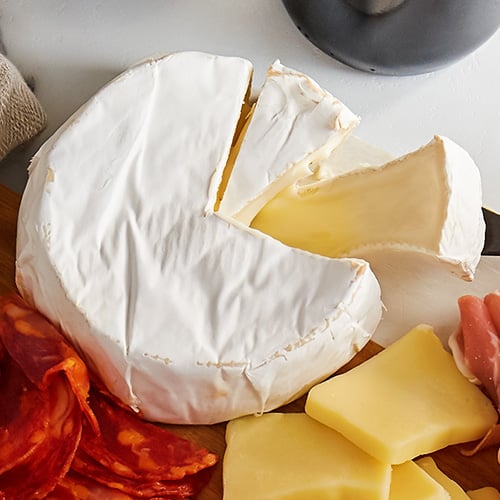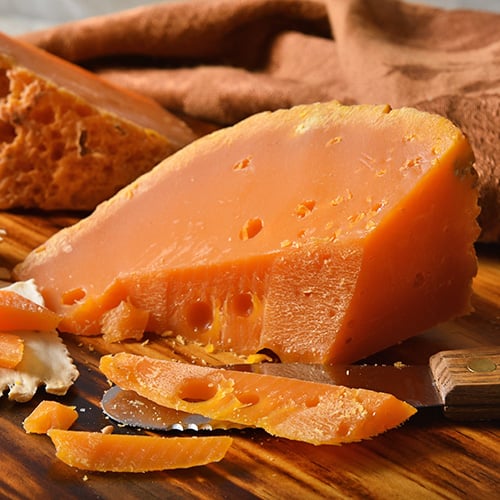In 15th-century France, charcuterie referred to the art of preparing cured meats. Fast forward 600+ years and charcuterie has evolved into a catch-all phrase describing meats, cheeses, nuts, fruits, and spreads artfully arranged on a board. The cheese is often a favorite feature of a charcuterie board, elevating the flavor of the other ingredients. Customers are looking for a taste of luxury from their charcuterie board cheeses, but they also tend to favor the familiar. If you're not sure which types of cheese to include, we have you covered. Use these gourmet yet well-known luxury fromages as the foundation of your cheese board menu.
Shop All Specialty Cheeses1. Burrata

Burrata (pronounced br-aa-tuh) is a fresh cheese from Italy's Puglia region. The traditional method of making Burrata involves stretching fresh mozzarella curds into a pouch-like shape, which is then filled with a mixture of cream and torn mozzarella pieces. The pouch is carefully sealed to create a smooth outer layer, resulting in a cheese that is both visually stunning and incredibly delicious. Burrata has a soft, silky exterior filled with a creamy and slightly stringy interior that oozes out when sliced open, adding a luxurious and indulgent element to any charcuterie board. It has a delicate and milky flavor that is complemented by a slight tanginess.
For optimal creaminess, let the burrata come to room temperature before serving. Cut into the cheese to reveal the velvety center, and allow it to ooze onto the plate for a visually appealing presentation. Sprinkle sea salt and drizzle EVOO (extra virgin olive oil) over burrata to enhance its delicate flavors. It pairs beautifully with fresh fruits like figs, peaches, or cherries. Nuts such as walnuts or almonds provide a crunchy texture that complements the smoothness of burrata. For a more robust flavor profile, consider serving burrata with roasted vegetables like eggplant or zucchini. Crispy crostini is also an excellent choice. When selecting a wine to accompany burrata, opt for a light and crisp white wine such as Pinot Grigio or Sauvignon Blanc. If you prefer red wine, choose a light-bodied red like Pinot Noir or Beaujolais to complement the cheese's creamy richness.
- Burrata Tasting Notes: Buttery, rich, creamy, subtly sweet
- Burrata Texture: Soft, fresh exterior and a creamy, milky interior
- Burrata Cheese Knife: Soft cheese knife, spreader knife
2. Parmesan

Originating from Italy, Parmesan is a hard, granular cheese that is typically aged for 12 to 36 months. It is made from cow's milk and has a pale yellow color with a sharp, nutty taste. Parmesan is often confused with Parmigiano Reggiano (pronounced pahr-mee-JAH-noh red-JAH-noh), but there are some key differences between the two. Parmigiano Reggiano is a Protected Designation of Origin (DOP) cheese from specific regions in Italy, and Parmesan is a more generic term used to describe similar cheeses made outside of these regions. Parmigiano Reggiano is known for its high quality and strict production standards, making it a premium choice for charcuterie boards.
To serve Parmesan on your charcuterie board, it is best to cut it into small wedges or cubes to make it easy for guests to enjoy. You can also shave or grate Parmesan over other foods to add a burst of flavor. Serve Parmesan at room temperature to allow its flavors to fully develop and provide the best tasting experience for your guests. It complements cured meats like prosciutto di Parma and salami, as well as fruits such as grapes, pears, strawberries, and apples. Parmesan also pairs nicely with honey, balsamic vinegar, and olives, adding depth and complexity to your charcuterie board. For wine pairings, Parmesan cheese complements medium to full-bodied wines such as Chianti, Merlot, and Cabernet Sauvignon. These wines help balance the sharpness of the cheese and enhance its flavors, creating a harmonious tasting experience.
- Parmesan Tasting Notes: Umami, salty, nutty undertones
- Parmesan Texture: Gritty
- Parmesan Cheese Knife: Parmesan knife, pronged cheese knife, cheese grater, cheese fork
3. Gruyere

Originating from the Gruyeres (groo-yehr) district in Switzerland, gruyere is an Alpine-style semi-hard cow's milk cheese. Made from raw cow's milk, gruyere is aged for a minimum of five months, developing its signature nutty and slightly funky flavor profile. During the aging process, the cheese is regularly turned and brushed with a saltwater brine, contributing to its unique texture, taste, and funky smell. As a type of stinky cheese, gruyere emits a strong, earthy scent, but don't let its pungent aroma fool you. The flavor of gruyere combines nutty, savory, and slightly sweet notes with a hint of earthiness. Its firm, dense, and granular consistency makes slicing and grating easy.
Gruyere is an excellent melting cheese, making it a classic choice for quiches, so consider adding mini gruyere quiches to your breakfast board. On a traditional charcuterie board, baked gruyere in puff pastry is a more complex alternative to baked Brie. The cheese's savory flavor contrasts well with fruits such as apples, pears, and dried apricots. Walnuts, hazelnuts, and almonds bring out the nutty notes of gruyere. Crusty bread or cured meats like bundnerfleisch (air-dried Swiss beef), speck, and salami are also excellent pairing choices. Its rich flavor profile pairs well with white wines such as Chardonnay or Sauvignon Blanc, as well as red wines like Pinot Noir or Merlot. The acidity and fruitiness of these wines enhance the flavors of the cheese, creating a delightful sensory experience for those enjoying a charcuterie board featuring gruyere.
- Gruyere Tasting Notes: Nutty, savory, earthy, subtle sweetness
- Gruyere Texture: Dense, grainy, slightly crumbly
- Gruyere Cheese Knife: Cheese cleaver
4. Brie

Originating from the Ile-de-France, Brie is a soft cow's milk cheese with a bloomy rind. Brie (pronounced bree) has a smooth and creamy texture with a slightly firm outer layer that gives way to a gooey interior as it ripens. It's known for its rich, buttery taste underscored by umami and mushroom notes. When serving Brie, a cheese knife with a thin blade and a sharp edge helps cut through the soft interior and rind without squishing the cheese. A cheese knife with a forked tip is also helpful for serving individual portions of Brie with ease. To achieve the ideal serving temperature, remove the cheese from the refrigerator at least 30 minutes before serving so it softens and reaches its peak flavor profile.
The creamy texture and mild flavor of Brie make it a crowd-pleaser that complements both savory and sweet components on a charcuterie board. Try drizzling hot honey over the Brie for a swicy complement to its creamy, mild flavor. Fruit preserves such as fig jam or apple butter are also excellent Brie enhancers, especially when scooped on a baguette slice or crunchy crackers. You can also serve it alongside fresh fruits like apples, grapes, pears, and berries. For savory accompaniments, classic cured meats like prosciutto or salami work wonderfully, as do briny olive varieties such as kalamata, Castelvetrano, or picholine.
- Brie Tasting Notes: Rich, buttery, nutty, mushroom essences
- Brie Texture: Creamy, soft interior with a firm rind
- Brie Cheese Knife: Tagliagrana, almond knife, or spade knife
5. Manchego

Originating from the La Mancha region of Spain, manchego is made from sheep's milk and has a distinct flavor and texture. To make Manchego, the milk is curdled using animal rennet and then pressed into molds to form its characteristic cylindrical shape. The cheese is then aged for a minimum of 60 days, with some varieties aging for up to two years, resulting in different flavor profiles. In general, manchego is known for its nutty and slightly tangy flavor, with hints of grassiness from the sheep's milk. Its high butterfat content (nearly double that of cow's milk cheese) creates a creaminess that balances its bold flavor. Its texture is firm and slightly crumbly, making it easy to slice and serve on a charcuterie board.
Manchego (pronounced man-chay-gow) requires a cheese knife with a sharp blade to cut through its firm texture. It should be served at room temperature to allow its flavors to develop. Manchego's robust taste can stand up to other bold flavors, making it a versatile cheese for pairing. Spicy meats and cured ham varieties such as jamon Iberico, chorizo, sopressata, and Serrano ham are all excellent meat pairing choices on a charcuterie board. Other Spanish tapas favorites like marcona almonds, olives, croquettes, patatas bravas, and pan con tomate create an authentic Spanish charcuterie board. For wine pairings, manchego complements Spanish wines such as Tempranillo or Rioja, as well as white wines like Albarino or Verdejo.
- Manchego Tasting Notes: Umami, tangy, nutty, slightly sweet, grassy essences
- Manchego Texture: Firm, crumbly, buttery
- Manchego Cheese Knife: Tagliagrana, almond knife, or spade knife
6. Chevre

Chevre (pronounced SHEV-ruh)) is a type of goat cheese that adds a unique touch to any charcuterie board. Originating from France, chevre has gained worldwide recognition for its unique flavor profile and creamy texture. Containing less lactose than cow's milk cheese, chevre can be a good option for those with lactose sensitivities, but not for those with a dairy allergy. To make chevre, fresh goat's milk is curdled and drained, resulting in a soft and spreadable cheese. It's then aged for a short period, typically a few days to a few weeks, to develop its distinct, tangy flavor. Chevre can also be flavored with herbs, spices, or fruits for additional depth.
For serving chevre, a cheese knife with a narrow blade and a sharp point allows for precise slicing, maintaining the integrity of the cheese's texture. Chevre has a tangy and slightly acidic flavor with earthy undertones, offering a refreshing addition to a charcuterie board. Its creamy, smooth texture is easy to spread on crackers or bread. Chevre pairs well with a variety of foods, including honey, figs, olives, and various nuts, adding a burst of flavor to each bite. When it comes to wine pairings, chevre complements crisp white wines such as Sauvignon Blanc or Pinot Grigio. The acidity of these wines balances the tanginess of the cheese, creating a harmonious combination for your palate.
- Chevre Tasting Notes: Tangy, acidic, earthy
- Chevre Texture: Spreadable, creamy
- Chevre Cheese Knife: Cheese spreader
7. Havarti

Havarti is a semi-soft cow's milk cheese that originated in Denmark. This creamy cheese (pronounced huh-vaar-tee) is named after the Havarthigaard farm, where it was first crafted in the mid-19th century. It's known for its smooth, buttery texture and mild, slightly tangy flavor. To make Havarti, fresh cow's milk is pasteurized and then mixed with a starter culture and rennet to begin the cheese-making process. The cheese curds are cut, drained, and pressed into molds before being aged for several months.
Havarti's mild and slightly tangy flavor makes it a popular choice for charcuterie boards, where it can complement a variety of meats, fruits, and nuts. The buttery texture of Havarti also makes it easy to spread on crackers or bread; consider adding some honey or fruit preserves to complement its mild flavor profile. Havarti pairs nicely with crisp, acidic, and light-bodied white wines such as Chardonnay or Sauvignon Blanc. Its mild, buttery flavor complements dessert wines such as Moscato, late-harvest Riesling, or a fortified wine like port. To serve Havarti, it is best to use a cheese knife with a thin blade and a sharp edge. This type of knife creates clean cuts through the cheese without causing it to crumble or stick to the blade.
- Havarti Tasting Notes: Buttery, sweet, subtly acidic
- Havarti Texture: Springy, semi-soft
- Havarti Cheese Knife: Cheese plane
8. Smoked Gouda

Originating from the Netherlands, Gouda cheese (pronounced goo-duh) is typically made from cow's milk and comes in various forms, including the smoked variety. To create smoked Gouda, the cheese is first aged to develop its characteristic flavor and texture. It is then cold-smoked and exposed to vapor from wood chips or other sources. This smoking process imparts a rich flavor to the cheese, enhancing its overall taste. Smoked Gouda is semi-soft and smooth, making it easy to slice or cube for serving on a charcuterie board.
Smoked Gouda is prized for its creamy, slightly sweet taste with a subtle smokiness that sets it apart from traditional Gouda cheese. Its flavor profile makes it a versatile option for pairing with cured meats such as prosciutto or salami, as well as fruits like apples or pears for a well-rounded charcuterie board experience. For wine pairings, consider serving smoked Gouda with a medium-bodied red wine such as Merlot or a crisp white wine like Chardonnay; because their fruity and acidic notes enhance the rich, smoky flavors of the cheese. To serve smoked Gouda on your charcuterie board, consider using a cheese fork. This specialized utensil is designed with sharp prongs to easily pick up and serve cheese without altering its shape or texture.
- Smoked Gouda Tasting Notes: Smoky, nutty, sweet, buttery
- Smoked Gouda Texture: Smooth and creamy when young, becomes firmer and more buttery the longer it ages
- Smoked Gouda Cheese Knife: Cheese fork
9. Comte

Comte (pronounced kaam-tee) is a French cheese from the Franche-Comte region in eastern France. This semi-hard cheese is made from unpasteurized cow's milk and boasts a rich history dating back to the 12th century. It's produced in cooperatives known as fruitieres where local dairy farmers bring their milk to be transformed into this delectable cheese. To craft Comte, the milk is heated and curdled before being pressed into large wheels and aged for a minimum of four months to several years. The extended aging process contributes to Comte's complex taste and distinctive texture. Comte is firm yet supple with a smooth, creamy mouthfeel. Its flavor profile ranges from savory to slightly sweet, with a lingering nuttiness that adds depth to any dish.
Thanks to its nutty flavor, Comte pairs well with almonds, pistachios, and cashews. It complements salty cured meats like pancetta, soppressata, and salami. Take a sweet turn and try pairing Comte with dark chocolate, candied nuts, or chutneys. To properly serve and enjoy Comte, it is recommended to use a hard cheese knife with a sharp blade and a sturdy handle. This type of knife allows for clean cuts through the firm texture of the cheese, ensuring a perfect presentation on your charcuterie board. When selecting a type of wine to pair with Comte, opt for a medium to full-bodied wine such as Chardonnay, Pinot Noir, or Beaujolais to complement the cheese's flavors without overpowering them.
- Comte Tasting Notes: Nutty, subtly sweet, fruity, grass essences
- Comte Texture: Semi-hard to hard
- Comte Cheese Knife: Hard cheese knife
10. Mimolette

Originating from France, specifically the northern regions of Normandy and Picardy, Mimolette is known for its distinctive orange hue and complex flavor profile. This cheese (pronounced mee-moh-lett) is made from cow's milk and undergoes a meticulous aging process that can last up to 24 months. During this time, the cheese develops a hard, crumbly texture with small crystals that add a delightful crunch to each bite. Mimolete's rich and nutty taste with hints of caramel and butterscotch make it a versatile option for charcuterie boards.
For its flavors to fully bloom, Mimolette is best served at room temperature. Use a sturdy cheese knife with a sharp edge to cut through its firm texture. It pairs well with dried fruits, nuts, and crusty bread. For a truly decadent appetizer pairing, slather a crostini with Pistacchiosa and a slice of Mimolette. Pistacchiosa is a sweet spread made with Sicilian pistachios, sugar, and extra virgin olive oil. For wine pairings, Mimolette complements both red and white wines. Choose a bold red wine like Cabernet Sauvignon or Bordeaux. Sparkling white wines like champagne can also enhance Mimolette's flavor.
- Mimolette Tasting Notes: Nutty, caramel, butterscotch, fruit essences
- Mimolette Texture: Hard
- Mimolette Cheese Knife: Tagliagrana
Cheese Board Tips

When preparing a charcuterie board, it is essential to pay attention to the cheese selection and presentation. Follow these cheese board tips to ensure you have the ideal serving sizes, preparations, and presentations for your guests.
- Serve Cheeses at Room Temperature: To fully appreciate the flavors and textures of the cheeses, it is recommended to serve them at room temperature. Take the cheeses out of the refrigerator about 30 minutes to an hour before serving to allow them to soften and develop their full flavor profiles. While you want them to soften, cheeses are still TCS foods, so pay attention to the time and temperature at catered events.
- Standard Serving of Cheese per Person: When planning the quantities of cheese for your charcuterie board, a standard serving size is approximately 2 to 3 ounces of cheese per person. This amount allows guests to sample a variety of cheeses without overwhelming their palates. Consider offering a selection of cheeses with different flavors and textures to cater to various preferences.
- Presentation: Arrange the cheeses on the board in an aesthetically pleasing way. Consider different shapes and sizes for visual appeal. Labeling the cheeses can also be helpful for guests who may not be familiar with the varieties.
- 3-3-3-3 Rule: The 3-3-3-3 Rule is a formula for making the perfect charcuterie board. To achieve a 3-3-3-3 board, include 3 cheeses, 3 meats, 3 starches (crackers, breads, pretzels), and 3 accompaniments (fruit, dips, nuts).
Gourmet Cheese Brands
To create a luxurious cheese board, you need to pay special attention to your sourcing and offer guests the quality they expect from a gourmet cheese platter. Purchase high-quality charcuterie cheeses from these respected suppliers. We included the highest-reviewed specialty cheese vendors on our site.
Eiffel Tower
Eiffel Tower stands out as a top gourmet cheese brand in the foodservice industry. As part of the Atalanta Corporation group of brands, which has over 50 years of experience in importing cheeses, Eiffel Tower is dedicated to importing high-quality cheeses that meet the standards of even the most discerning chefs and food enthusiasts. This means that when you choose Eiffel Tower cheese products, you can be confident that you are getting some of the finest cheeses available on the global market.
- Average Price Point: .46 cents per ounce
- Cheeses: Brie, camembert
See what our customers are saying about Eiffel Tower here!

Celebrity Goat
Celebrity Goat has been a prominent gourmet cheese brand since its establishment in 1987. The brand is known for its commitment to quality and tradition, using 100% pure goat's milk sourced from family-run farms in Ontario, Canada. By prioritizing the use of locally sourced ingredients, Celebrity Goat ensures that their cheeses are of the highest quality while supporting local farmers.
- Average Price Point: .66 cents per ounce
- Flavors: Plain goat cheese log, goat cheese crumbles, fig goat cheese, garlic and herb goat cheese, honey goat cheese, cranberry cinnamon chevre goat cheese
See what our customers are saying about Celebrity Goat here!

Traditional Delights
Traditional Delights sets itself apart through its dedication to slow-smoking its cheeses with hickory wood chips. This meticulous process imparts a distinctive smoky flavor that elevates the taste of their cheeses to new heights. Whether you're looking for a bold and robust flavor or a subtle and nuanced taste, Traditional Delights has a smoked cheese that will satisfy your cravings.
- Average Price Point: .31 cents per ounce
- Flavors: Smoked gouda
See what our customers are saying about Traditional Delights here!

Stella
Stella has been a pioneer in the industry since its establishment in 1923. Operating from a state-of-the-art facility located in Lincolnshire, Illinois, Stella benefits from access to high-quality milk, ensuring the production of premium cheeses. As a Saputo brand, Stella infuses rich Italian traditions and culture into every wheel of cheese, combining the freshest ingredients with old-world craftsmanship and culinary excellence.
- Average Price Point: .39 cents per ounce
- Cheeses: Parmesan, asiago
See what our customers are saying about Stella here!

Disclaimer: The average price point is determined at the time of publication. Check product pages for current prices.
Back to TopThe plating process of modern charcuterie has become more important than the food itself, and you'll see trendy charcuterie presentations breaking the board model and using cones, jars, and other creative vessels. Whatever you choose to serve it in, having a premium selection of cheeses can make or break a charcuterie board. Use our list of charcuterie cheeses to upgrade your happy hour menu or create gourmet appetizers at a catered event.








